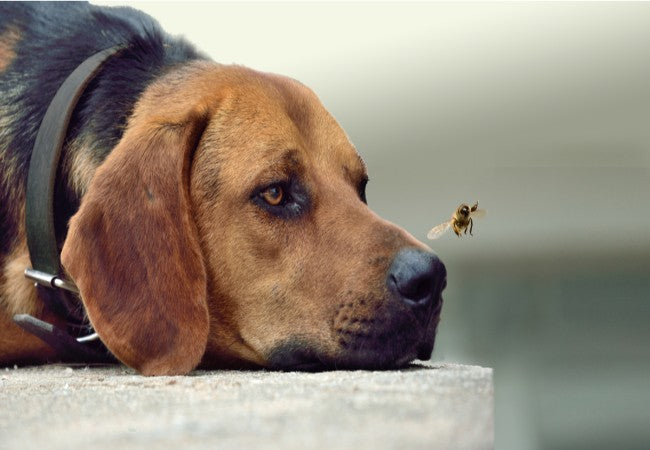Vet Approved Guide Getting Flies Off Your Dog 2025 🐶🩺

In this article
Vet Approved Guide Getting Flies Off Your Dog 2025 🐶🩺
By Dr. Duncan Houston BVSc
If your dog is being swarmed by flies, you're not alone. As a veterinarian, I regularly treat dogs with fly bites, infected ears, and even dangerous conditions like fly strike. While a few harmless visitors may just be annoying, some flies can cause painful bites, transmit disease, and put your dog at serious risk—especially during warmer months. 🌞🐶
This guide covers everything you need to know: why flies target dogs, how to safely remove them, how to treat fly bites, and how to prevent them long-term using safe products, lifestyle adjustments, and expert support from Ask A Vet. 🩺
❓ Why Are Flies Attracted to Dogs?
Flies are drawn to dogs for several reasons:
- 🦴 Food residue around the mouth or fur
- 🩹 Open wounds or sores
- 💩 Fecal residue or soiled fur
- 🌡️ Warm, moist environments (especially in summer)
Some dogs are more at risk—particularly outdoor dogs, long-haired breeds with poor hygiene, or those with skin conditions. 🐕
🚨 Understanding Fly Strike (Myiasis)
Fly strike occurs when flies lay eggs in open wounds or moist areas of a dog’s body, leading to maggot infestation. This condition is most common in:
- 🐾 Dogs with untreated wounds or skin infections
- 👵 Older, immobile, or incontinent pets
- 🌧️ Dogs left outside in hot, humid conditions
Fly strike is a veterinary emergency. Symptoms include foul odor, visible maggots, intense itching, or tissue necrosis. If suspected, seek immediate help through Ask A Vet or your nearest clinic. 🆘
🧼 How to Safely Remove Flies from Your Dog
Step-by-Step:
- 🪟 Move your dog indoors or into a shaded area
- 🧽 Wipe down your dog’s coat with a damp cloth
- 🧴 Use pet-safe fly repellent spray (avoid DEET)
- 🧼 Bathe with antibacterial shampoo if needed
Avoid essential oils like tea tree or eucalyptus unless directed by a vet—they can be toxic to dogs. 🛑
💥 Treating Fly Bites on Dogs
Fly bites often appear as red, crusty spots—especially on ears, face, and tail. Here's how to treat them:
- 🧴 Clean the area with saline or chlorhexidine solution
- 💊 Apply antibiotic ointment (pet-safe only)
- 🧢 Use a fly repellent cream or ear barrier balm
- 📱 Monitor for swelling, pus, or worsening—use Ask A Vet if unsure
Persistent wounds or signs of infection need veterinary attention. Don’t delay. 🩺
🛡️ Preventing Future Fly Problems
1. 🧼 Keep Your Dog Clean
- 🚿 Bathe regularly—especially after outdoor play
- 🧻 Wipe paws and underbelly after muddy walks
- ✂️ Trim matted fur where dirt collects
2. 🌿 Use Natural Fly Repellents
- 🧴 Pet-safe sprays with neem, citronella, or lemongrass
3. 🏠 Improve Your Dog’s Environment
- 🚫 Remove poop immediately from the yard
- 🛏️ Keep bedding clean and dry
- 🌬️ Use fans or shaded areas to deter flies
📋 Breed-Specific Risk Tips
- 🐕 Bulldogs and Shar-Peis: Extra skin folds can attract moisture and flies
- 🐩 Poodles and Doodles: Need trimmed coats and frequent brushing
- 🏕️ Outdoor breeds (e.g., Huskies): More prone to wounds from outdoor play
Ask your vet for a grooming and prevention routine tailored to your pet. Or consult virtually with Ask A Vet. 🩺📱
🧠 Behavioral Support for Fly-Averse Dogs
Dogs often become fearful or agitated when flies harass them. Some may:
- 🌀 Spin, snap at the air, or chase their tail
- 😨 Hide or become withdrawn
- 📉 Lose appetite or sleep
✅ Final Takeaways: Keep Flies Off, Comfort On
Flies may seem like a minor nuisance, but they can cause serious harm to dogs if ignored. From fly bites to life-threatening fly strike, prevention and quick action are key. 🛡️🐶
Quick Recap:
- 🪰 Flies are attracted to wounds, dirt, and outdoor conditions
- 🧼 Bathe, clean, and use pet-safe repellents to protect your dog
- 🩺 Treat bites carefully and consult vets for signs of infection
- 📱 Use Ask A Vet for fast guidance and wound care support
Need help now? Visit AskAVet.com.






